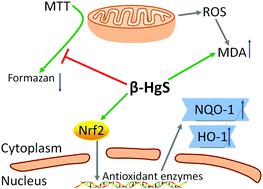当前位置:
X-MOL 学术
›
Metallomics
›
论文详情
Our official English website, www.x-mol.net, welcomes your
feedback! (Note: you will need to create a separate account there.)
Effects of β-HgS on cell viability and intracellular oxidative stress in PC-12 cells.
Metallomics ( IF 2.9 ) Pub Date : 2020-06-22 , DOI: 10.1039/d0mt00088d Lujing Geng 1 , Zhenghua Xia 1 , Lu Yuan 1 , Cen Li 2 , Ming Zhang 2 , Yuzhi Du 2 , Lixin Wei 2 , Hongtao Bi 3
Metallomics ( IF 2.9 ) Pub Date : 2020-06-22 , DOI: 10.1039/d0mt00088d Lujing Geng 1 , Zhenghua Xia 1 , Lu Yuan 1 , Cen Li 2 , Ming Zhang 2 , Yuzhi Du 2 , Lixin Wei 2 , Hongtao Bi 3
Affiliation

|
Traditional Tibetan medicines containing β-HgS have been used to treat chronic ailments for thousands of years. However, there has recently been speculation regarding the safety of these medicines due to their high mercury content. Although the toxic effect of β-HgS has been previously investigated in vivo, the mechanism underlying the toxicity of this compound remains unclear. In this study, we investigate the mechanism of β-HgS cytotoxicity via experiments performed on rat adrenal gland tumor cells (PC-12). Specifically, we analyze the viability and intracellular oxidative stress state of PC-12 cells treated with varying concentrations of β-HgS. For comparison purposes, the effects of MeHgCl and HgCl2, two Hg-based compounds, on ROS generation and MDA, GSH/GSSG, Nrf2, NQO-1, and HO-1 levels are also determined. It should be noted that we used the small-molecule thiols of cell culture medium, such as cysteine, to increase the solubility of β-HgS and prepare a β-HgS solution to treat PC-12 cells. The obtained results show that β-HgS inhibits cell viability at concentrations of 200–1000 ng Hg mL−1 (48 h treatment). In the concentration range of 200–600 ng Hg mL−1 (24 h treatment), the inhibitory effect of β-HgS is stronger than that of MeHgCl; however, this trend is reversed at higher concentrations (800–1000 ng mL−1) and longer exposure times (48 h). Moreover, β-HgS significantly promotes MDA, but has no appreciable influence on cell apoptosis and ROS generation in PC-12 cells, which suggests that its inhibitory effect on cell viability might be related to the stimulation of ROS-independent oxidative stress. Notably, β-HgS and HgCl2 significantly increase the GSH content, GSH/GSSG ratio, NQO-1 mRNA expression, and HO-1 protein expression in PC-12 cells, indicating that the antioxidant protection against these compounds is triggered by Nrf2 activation. HPLC-AFS analysis shows that in β-HgS and HgCl2 solutions, mercury exists in the same form of Hg2+, but the cytotoxicity of the former is greater. This is probably due to the additional oxidative damage induced by the S2− ion in β-HgS. In conclusion, β-HgS induces ROS-independent oxidative stress in PC-12 cells, and thus, is obviously cytotoxic. At the same time, it promotes the antioxidant capacity of cells by activating the Nrf2 pathway.
中文翻译:

β-HgS 对 PC-12 细胞活力和细胞内氧化应激的影响。
含有 β-HgS 的传统藏药已被用于治疗慢性疾病数千年。然而,由于这些药物的汞含量高,最近有人猜测它们的安全性。尽管先前已在体内研究了 β-HgS 的毒性作用,但该化合物毒性的潜在机制仍不清楚。在本研究中,我们通过对大鼠肾上腺肿瘤细胞 (PC-12)进行的实验研究了 β-HgS 细胞毒性的机制。具体来说,我们分析了用不同浓度的 β-HgS 处理的 PC-12 细胞的活力和细胞内氧化应激状态。为了比较,MeHgCl 和 HgCl 2 的影响,两种基于汞的化合物,在 ROS 生成和 MDA、GSH/GSSG、Nrf2、NQO-1 和 HO-1 水平上也被确定。需要说明的是,我们利用细胞培养基中的小分子硫醇,如半胱氨酸,来增加β-HgS的溶解度,制备β-HgS溶液来处理PC-12细胞。获得的结果表明,β-HgS 在 200-1000 ng Hg mL -1 的浓度下抑制细胞活力(处理 48 小时)。在200-600 ng Hg mL -1浓度范围内(24 h处理),β-HgS的抑制作用强于MeHgCl;然而,这种趋势在较高浓度(800–1000 ng mL -1) 和更长的曝光时间 (48 小时)。此外,β-HgS 显着促进 MDA,但对 PC-12 细胞的细胞凋亡和 ROS 产生没有明显影响,这表明其对细胞活力的抑制作用可能与刺激不依赖 ROS 的氧化应激有关。值得注意的是,β-HgS 和 HgCl 2显着增加 PC-12 细胞中 GSH 含量、GSH/GSSG 比率、NQO-1 mRNA 表达和 HO-1 蛋白表达,表明对这些化合物的抗氧化保护是由 Nrf2 激活触发的. HPLC-AFS分析表明,在β-HgS和HgCl 2溶液中,汞以相同形式的Hg 2+ 存在,但前者的细胞毒性更大。这可能是由于 S 诱导的额外氧化损伤β-HgS 中的2−离子。总之,β-HgS 在 PC-12 细胞中诱导不依赖于 ROS 的氧化应激,因此具有明显的细胞毒性。同时通过激活Nrf2通路来促进细胞的抗氧化能力。
更新日期:2020-06-22
中文翻译:

β-HgS 对 PC-12 细胞活力和细胞内氧化应激的影响。
含有 β-HgS 的传统藏药已被用于治疗慢性疾病数千年。然而,由于这些药物的汞含量高,最近有人猜测它们的安全性。尽管先前已在体内研究了 β-HgS 的毒性作用,但该化合物毒性的潜在机制仍不清楚。在本研究中,我们通过对大鼠肾上腺肿瘤细胞 (PC-12)进行的实验研究了 β-HgS 细胞毒性的机制。具体来说,我们分析了用不同浓度的 β-HgS 处理的 PC-12 细胞的活力和细胞内氧化应激状态。为了比较,MeHgCl 和 HgCl 2 的影响,两种基于汞的化合物,在 ROS 生成和 MDA、GSH/GSSG、Nrf2、NQO-1 和 HO-1 水平上也被确定。需要说明的是,我们利用细胞培养基中的小分子硫醇,如半胱氨酸,来增加β-HgS的溶解度,制备β-HgS溶液来处理PC-12细胞。获得的结果表明,β-HgS 在 200-1000 ng Hg mL -1 的浓度下抑制细胞活力(处理 48 小时)。在200-600 ng Hg mL -1浓度范围内(24 h处理),β-HgS的抑制作用强于MeHgCl;然而,这种趋势在较高浓度(800–1000 ng mL -1) 和更长的曝光时间 (48 小时)。此外,β-HgS 显着促进 MDA,但对 PC-12 细胞的细胞凋亡和 ROS 产生没有明显影响,这表明其对细胞活力的抑制作用可能与刺激不依赖 ROS 的氧化应激有关。值得注意的是,β-HgS 和 HgCl 2显着增加 PC-12 细胞中 GSH 含量、GSH/GSSG 比率、NQO-1 mRNA 表达和 HO-1 蛋白表达,表明对这些化合物的抗氧化保护是由 Nrf2 激活触发的. HPLC-AFS分析表明,在β-HgS和HgCl 2溶液中,汞以相同形式的Hg 2+ 存在,但前者的细胞毒性更大。这可能是由于 S 诱导的额外氧化损伤β-HgS 中的2−离子。总之,β-HgS 在 PC-12 细胞中诱导不依赖于 ROS 的氧化应激,因此具有明显的细胞毒性。同时通过激活Nrf2通路来促进细胞的抗氧化能力。











































 京公网安备 11010802027423号
京公网安备 11010802027423号